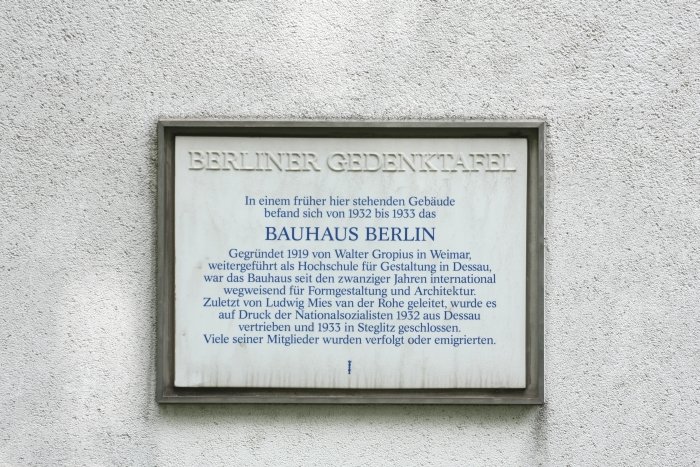"Herr Mies van der Rohe proposed to close Bauhaus. The proposition was unanimously approved".
With this sober protocol dated July 20th 1933, but referring to a meeting held on July 19th 1933, the closing of Bauhaus Berlin, and so the end of the Bauhaus story, is formally confirmed.
Present at the meeting on July 19th, and so unified in their responsibility for the decision were, in addition to Mies van der Rohe, Josef Albers, Ludwig Hilberseimer, Wassily Kandinsky, Walter Peterhans, Lilly Reich and "Walther" - a person we can't further identify, but suspect Walther "Walter" Gropius is meant.
Although the decision was formally taken on July 19th, with hindsight its probably fair to say the closure had been inevitable since the local elections of October 1931 which saw the Nazis take power in Dessau.
Before and during the election the Nazis had campaigned against the "Bolshevik" Bauhaus with its foreign teaching staff and un-Aryan principles; consequently, upon them assuming power in Dessau it was only a matter of time before the school was closed. Something which was confirmed on August 22nd 1932 when Dessau town council voted to enforce the closure of Bauhaus Dessau. Four weeks later the "mission" was accomplished
Although at that time Bauhaus had formal offers to relocate to either Leipzig or Magdeburg, Mies van der Rohe had already decided that the school would move to Berlin.
On the 10th of October 1933 Mies van der Rohe signed a rental agreement for a former telephone factory in Birkbuschstrasse in the leafy Berlin suburb of Steglitz and on January 3rd 1933 teaching at Bauhaus Berlin formally began.
On April 11th 1933 the Gestapo raided Bauhaus Berlin on the orders of the Dessau public prosecutors office, ostensibly looking for evidence in context of an investigation against the former Dessau mayor. The charge? Supporting Bauhaus. Following the search the building was sealed and entry banned. In effect the school was closed. Unable to collect teaching fees from students and with income from licensing fees dropping, Bauhaus Berlin's less than stable financial situation worsened. And became critical when the authorities in Dessau cancelled an agreement to pay the wages of the Bauhaus teaching staff.
The end was no longer neigh. But there.
In a letter to students on August 10th 1933 informing of the decision to close Bauhaus Mies van der Rohe writes that the "difficult economic situation" was responsible. And certainly in the protocol from July 20th Mies van der Rohe notes that the financial situation of the school "is so negative that a redevelopment of Bauhaus cannot be considered"
Although one must always add the conduit that the financial situation wouldn't have been so dramatic if the Nazis hadn't interfered to the level they had......
Whatever the decisive reason for the schools closing was, we believe it is good that it did close. As an institution Bauhaus was very much of and geared for its time: Design and architecture however need to have contemporary influences. And given the social, political and cultural change that occurred in the wake of the Second World War, a post-war Bauhaus run on the same principles as the pre-war Bauhaus would have been an ungainly beast. But Bauhaus closed, its leading protagonists went of into the world and developed remarkable projects, buildings and educational institutions: and in the void that was left came a new generation of architects and designers who adapted what Bauhaus had taught us and applied that to their age. People like Rudolf Horn.
And today, exactly 81 years since the decision was made to close Bauhaus, architecture and design students at the Berlin Universität der Künste and the Kunsthochschule Weißensee are presenting the results of their work from the past year. Work unquestionably influenced by the legacy of Bauhaus and European Modernism, yet free from the pressures to conform to preconceived ideas of a "living" Bauhaus tradition. Although we suspect, indeed hope, that amongst the current generation of Berlin architecture and design students one or the other Bolshevik is to be found. It would certainly be fitting.
And certainly more fitting than the unkempt plaque that marks the spot - or at least a spot relatively close to the spot - where one of the most important movements in European architecture and design history met its end....
